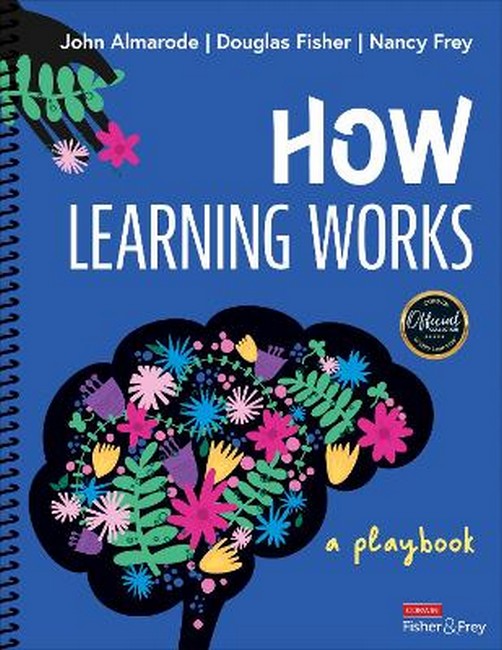Acknowledgments INTRODUCTION The Purpose of This Learning Playbook The Learning Plan With the Modules Learning Within the Modules Collaborating for Great Learning PART I CHAPTER 1. WHAT DOES LEARNING LOOK LIKE IN YOUR CLASSROOM? A Definition of Learning Checks for Understanding CHAPTER 2. WHAT ARE DIFFERENT WAYS TO THINK ABOUT LEARNING? Three Different Types of Knowledge Three Parts of the Learning Process Checks for Understanding CHAPTER 3. WHAT ARE THE BARRIERS TO LEARNING? Acquisition Consolidation Storage Challenges to Learning by Design Checks for Understanding CHAPTER 4. HOW DO STUDENTS LEARN? Learning Myths The Science of Learning Checks for Understanding PART II CHAPTER 5. PROMISING PRINCIPLE 1: MOTIVATION What Is Motivation? What Does This Principle or Practice Look Like in the Classroom? How Do We Implement This Principle and Practice Into Our Classrooms? Checks for Understanding CHAPTER 6. PROMISING PRINCIPLE 2: ATTENTION What Is Attention? Factors Influencing Attention What Does This Principle or Practice Look Like in the Classroom? How Do We Implement This Principle and Practice Into Our Classrooms? Checks for Understanding CHAPTER 7. PROMISING PRINCIPLE 3: ELABORATE ENCODING What Is Elaborate Encoding? Components of Elaborate Encoding Approaches to Promoting Elaborate Encoding What Does This Principle or Practice Look Like in the Classroom? How Do We Implement This Principle and Practice Into Our Classrooms? Checks for Understanding CHAPTER 8. PROMISING PRINCIPLE 4: RETRIEVAL AND PRACTICE What Is Retrieval and Practice? Timing of Retrieval Types of Retrieval Practice What Does This Principle or Practice Look Like in the Classroom? How Do We Implement This Principle and Practice Into Our Classrooms? Checks for Understanding CHAPTER 9. PROMISING PRINCIPLE 5: COGNITIVE LOAD What Is Cognitive Load? What Does This Principle or Practice Look Like in the Classroom? How Do We Implement This Principle and Practice Into Our Classrooms? Checks for Understanding CHAPTER 10. PROMISING PRINCIPLE 6: PRODUCTIVE STRUGGLE What Is Productive Struggle? What Does This Principle or Practice Look Like in the Classroom? How Do We Implement This Principle and Practice Into Our Classrooms? Checks for Understanding CHAPTER 11. PROMISING PRINCIPLE 7: FEEDBACK What Is Feedback and What Makes It Effective? What Does This Principle or Practice Look Like in the Classroom? How Do We Implement This Principle and Practice Into Our Classrooms? Checks for Understanding Where to Next? PART III CHAPTER 12. EXPLICIT STRATEGY INSTRUCTION The Gradual Release of Responsibility Effective Learning Practices A Return to Germane Cognitive Load Checks for Understanding CHAPTER 13. LEARNING STRATEGY 1: GOAL SETTING The Benefits of Goal Setting Getting Ready for Goal Setting The Process of Goal Setting Checks for Understanding CHAPTER 14. LEARNING STRATEGY 2: INTEGRATING PRIOR KNOWLEDGE The Benefits of Integrating Prior Knowledge Getting Ready to Integrate Prior Knowledge A Process for Integrating Prior Knowledge Bonus Material: Annotated Reading Checks for Understanding CHAPTER 15. LEARNING STRATEGY 3: SUMMARIZING Essential Characteristics of Summarizing Getting Ready to Summarize A Process for the Explicit Instruction of Summarizing Checks for Understanding CHAPTER 16. LEARNING STRATEGY 4: MAPPING Three Different Ways to Map Getting Ready for Mapping A Process for the Explicit Instruction of Summarizing Checks for Understanding CHAPTER 17. LEARNING STRATEGY 5: SELF-TESTING Benefits of Self-Testing What if Learners Make Mistakes? Getting Ready to Implement Self-Testing A Process for Implementing Self-Testing Bonus Material: Cooperative Learning Checks for Understanding CHAPTER 18. LEARNING STRATEGY 6: ELABORATIVE INTERROGATION Benefits of Elaborative Interrogation Getting Ready to Implement Elaborative Interrogation Bonus Material: Jigsaw A Process for Implementing Elaborative Interrogation Checks for Understanding PART IV CHAPTER 19. GENERATING AND GATHERING EVIDENCE Planning for Evaluation Success Criteria and Evaluation Planning to Gather Evidence Planning to Collect and Organize Evidence Making Sense of the Evidence Conclusion References Index About the Authors

